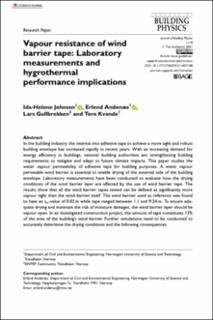| dc.contributor.author | Johnsen, Ida-Helene | |
| dc.contributor.author | Andenæs, Erlend | |
| dc.contributor.author | Gullbrekken, Lars | |
| dc.contributor.author | Kvande, Tore | |
| dc.date.accessioned | 2022-01-18T08:18:13Z | |
| dc.date.available | 2022-01-18T08:18:13Z | |
| dc.date.created | 2021-11-26T14:06:13Z | |
| dc.date.issued | 2021 | |
| dc.identifier.issn | 1744-2591 | |
| dc.identifier.uri | https://hdl.handle.net/11250/2837774 | |
| dc.description.abstract | In the building industry, the interest into adhesive tape to achieve a more tight and robust building envelope has increased rapidly in recent years. With an increasing demand for energy efficiency in buildings, national building authorities are strengthening building requirements to mitigate and adapt to future climate impacts. This paper studies the water vapour permeability of adhesive tape for building purposes. A water vapour permeable wind barrier is essential to enable drying of the external side of the building envelope. Laboratory measurements have been conducted to evaluate how the drying conditions of the wind barrier layer are affected by the use of wind barrier tape. The results show that all the wind barrier tapes tested can be defined as significantly more vapour tight than the wind barrier itself. The wind barrier used as reference was found to have an sd-value of 0.03 m while tape ranged between 1.1 and 9.24 m. To ensure adequate drying and minimize the risk of moisture damages, the wind barrier layer should be vapour open. In an investigated construction project, the amount of tape constitutes 13% of the area of the building’s wind barrier. Further simulations need to be conducted to accurately determine the drying conditions and the following consequences. | |
| dc.language.iso | eng | |
| dc.publisher | Sage | |
| dc.rights | CC BY 4.0 | |
| dc.rights.uri | https://creativecommons.org/licenses/by/4.0/ | |
| dc.subject | Adhesive Tape | |
| dc.subject | Construction tape | |
| dc.subject | Water vapour permeability | |
| dc.subject | sd-value | |
| dc.subject | Laboratory measurements | |
| dc.title | Vapour resistance of wind barrier tape: Laboratory measurements and hygrothermal performance implications | |
| dc.type | Peer reviewed | |
| dc.type | Journal article | |
| dc.description.version | publishedVersion | en_US |
| dc.rights.holder | © 2021 The authors | |
| dc.subject.nsi | VDP::Teknologi: 500 | |
| dc.source.journal | Journal of Building Physics | |
| dc.identifier.doi | 10.1177/17442591211057188 | |
| dc.identifier.cristin | 1959840 | |
| dc.relation.project | Norges forskningsråd: 237859 | |
| dc.relation.project | Norges forskningsråd: 294894 | |
| cristin.ispublished | true | |
| cristin.fulltext | original | |
| cristin.qualitycode | 2 | |

